Q&A – Ask Neil: August 17, 2023
(Please read these instructions carefully.)
Before you post your question, please look at recent issues to see if someone else has already asked it. You might find your answer there.
How to submit your question…
(Note: You may need to allow a pop-up window to come up in order to get the link for sending your photo(s). If you have already submitted your question and didn’t see the pop-up window, please click here.)
• Click the link provided below to post your question. After you submit your question, a new window will pop up giving you the address to which you can e-mail a SHARP, HIGH-RESOLUTION PHOTO to accompany your question. Please DO NOT SEND THUMBNAIL PHOTOS in case I need to zoom in to see things.
• Click here to post your question.
• Please ONLY POST YOUR QUESTION ONE TIME. We can only accept a set number of questions each week, and when we get duplicates it costs other people their chances.
• One question per reader, please.
• Please use this only for posting questions – not for standard emails.
• Watch for your answer in the following week’s e-gardens.
• I choose those of greatest general interest. For example, plant IDs seldom make the cut.
• I must have your first name or initials.
• I must have your city or county. (Texas is a very large state.)
QUESTION 1
WHAT CAN I DO ABOUT FAIRY RINGS THAT ARE KILLING MY LAWN?
Question: I’ve been told by lawn care companies that fairy rings are killing my turfgrass. I have two big oak trees in that area. I’ve been told there is no treatment for it on the market yet. What do you know about it? Any suggestions? Anne S., Dallas.
Answer: A photo really would have helped. Fairy rings develop where one of the several dozen species of funguses gets a start in a lawn, then gradually expands its territory, much like ripples on a pond. As it does, mushrooms or puffballs may or may not be produced along the line of development, and the grass along the line may or may not change its color for a period of time.
Since you mentioned two large trees being in the same area, I’m going to say that in my career, I’ve had probably 20,000 examples of excessive shade causing grass to die out to every one example (you) of fairy rings causing that to happen.
I spent 30 minutes online seeing what universities had to say. All said that it is uncommon for fairy rings to kill areas of lawns, although it could happen.
Here are links to the three best write-ups I found.
From Kansas State University, a simple and well-illustrated explanation.
From North Carolina State University, a highly detailed explanation for anyone wanting to know every last fact.
From Cornell, long known to be a source of accurate research-driven information.
QUESTION 2
WHAT HAS HAPPENED TO OUR MONTERREY OAK?
Question: Our Monterrey oak has large amounts of suckers at its bottom, and its leaves are light green and yellow. There is a section of loose bark. We have mulched it and applied tree fertilizer. What is going wrong with it? Teresa L., Bandera.
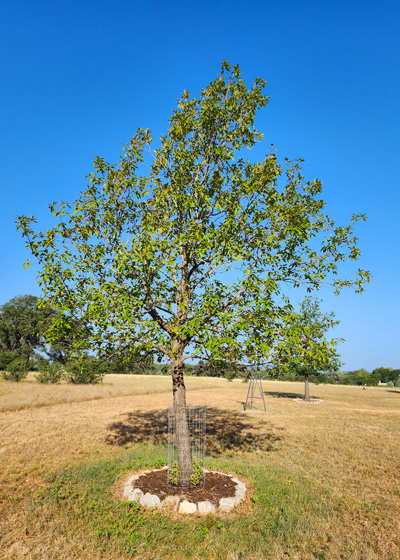

Answer: You may have seen similar questions about live oaks and Shumard red oaks here over the past several months. It’s all a function of the extreme cold of February 2021, and the splitting of the bark is called “radial shake.”
Looking at your distant photo, it appears that there is still a fair amount of foliage on the tree, so we can hope that it will recover. I will tell you that I have had several dozen questions on Monterrey oaks, including many that were killed entirely by the cold. Time will tell whether your tree is going to turn things around. Fertilize it in spring and again around the first of September with a water-soluble, high-nitrogen food. Do not attempt to peel the loose bark away. Let nature take its course and hope for the best. It might be best not to plant any more Monterrey oaks into your landscape. They have proven that they aren’t reliably winter hardy in your area.
QUESTION 3
HOW CAN I ELIMINATE ST. AUGUSTINE FROM OUR YARD?
Question: I live in an HOA where we are forbidden to have St. Augustine in our lawns. I found it growing in my side yard. I have no idea how it got there. However, I do know that it is spreading and that I have to get rid of it. Any suggestions? Gail P., Frisco.
Answer: The herbicide MSMA was what we used for decades. It would kill St. Augustine without harming bermudagrass. However, it was taken off the consumer market 12 or 14 years ago. Oddly, some lawn care companies still seem to have it for use for very specific purposes, for example in golf courses and highway rights-of-way. You might talk with them. Failing at that, people are always telling me how they’re able to find it on the Internet. You might alert your HOA of your dilemma and ask how they propose the St. Augustine be eliminated. (Side issue: I wonder what turfgrass they’re going to suggest when bermuda fails due to insufficient sunlight.)
QUESTION 4
IS THIS A REALLY BAD YEAR FOR SPIDER MITES?
Question: I work at a landscaping company in DFW. We are seeing spider mites in a huge percentage of our properties. They are killing plants in just days/weeks. Are you hearing this from others? Carrie H., Fort Worth.
Answer: I’m hearing this and I’m seeing it, most notably on conifers such as junipers and Italian cypresses. Also, of course, their standard victims, annuals like marigolds, very old tomatoes and others. I mentioned to a couple of callers on my radio program last weekend that spider mites are the smallest pests that we have here in Texas, yet they do more damage than any other.

Note: Here is a photo example of spider mites on a juniper from one of my readers. They are virtually microscopic. I always tell people that you could put 20 of them side-by-side on the head of a pin. If you thump one of the branches that is infested over a sheet of white paper, you will see them scurrying around. Since we no longer have our miticide Kelthane you will need to look for a general-purpose insecticide that is labeled for spider mites or red spider mites. Be sure to spray all surfaces of plants’ leaves for best control. Check the plants again in a few days to see if they are still active.
QUESTION 5
WHAT IS WRONG WITH MY ST. AUGUSTINE?
Question: I moved into my new home in July 2022. The new sod that year looked great, but this summer it has not. I have watered regularly and treated for weeds. The other parts of my St. Augustine have done great. Any idea what’s going on? Chris O., Midlothian, Ellis County.
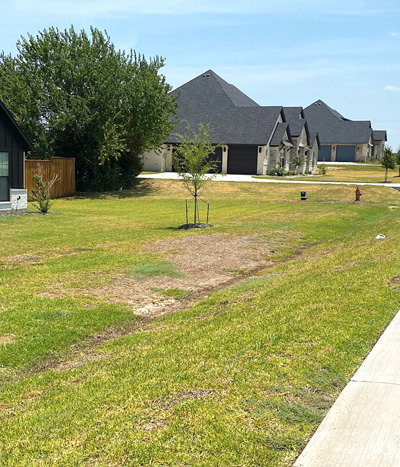
Answer: I’m going to offer several comments. They may seem a bit disjointed, but I do believe they will all play into solving your problem. I’ll even separate them so you can see them as distinct thoughts.
1. Midlothian is known for having very shallow topsoil. It’s not easy to grow lawns or landscapes in that sort of setting. It forces you to water and fertilize more often and in smaller “doses,” but that’s not the main problem here. However, it does weaken the grass.
2. It has been very dry, as visible from all of the grass on your street. We have to be willing to accept some degree of summer “dormancy” brought on by heat and drought. However, there are bigger problems to be seen, so I’ll continue.
3. It looks like the mower may be set to cut too low. While I don’t suggest raising a mower above the recommended mowing height for any type of turfgrass (2-1/2 or 3 inches for St. Augustine), this appears to be set lower than that.
4. It’s possible that gray leaf spot is causing the yellowing across the lawn, notably in the bank near the camera/near the curb. If you see irregular diamond-shaped lesions on the blades and stems, that’s the source of the problem. It’s caused by a fungus, and the fungicide Azoxystrobin will lessen it. Our temptation is to apply nitrogen when we see yellow lawns, but that makes the gray leaf spot problem much worse. Wait until things cool down in September to apply a high-nitrogen fertilizer to your lawn. Look for one with 30 to 35 percent of that nitrogen in slow-release form.
5. By far the biggest problem I see is damage of chinch bugs. Please read through this link of St. Augustine diagnostics from my website and scroll down to the information on chinch bugs. You’ll see what they look like so that you can inspect the area around that large dead spot. They will be in the peripheral space where the grass is going downhill. (There is also information about gray leaf spot in that story.)
QUESTION 6
WHAT IS WRONG WITH MY REDBUD TREE?
Question: What is wrong with my redbud tree? I have two side by side. One looks great, and this is the other. What do I need to do? Glenna S., Arlington.
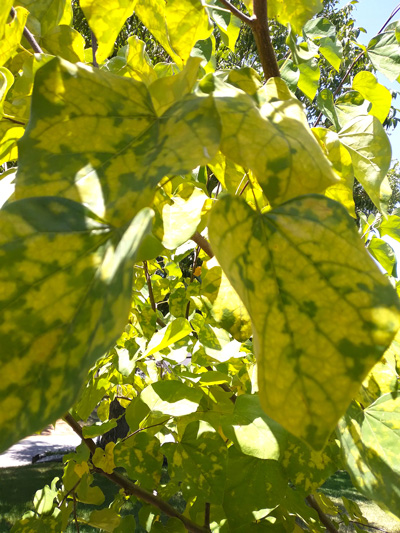
Answer: I am not sure. This does not appear to be any disease with which I’m familiar. If I were to guess (all three of my thoughts are really random), I would say that this tree could have been impacted by a virus that is affecting production of chlorophyll. Or, it might be drift of a weedkiller, either through the air or washed across the soil in a rain. Some weed-and-feed fertilizers will cause this kind of abnormal growth and coloration. And the third possibility would be of a gas leak. It’s more common than we think, and in heavy soils the gas will stay in one general location. That would explain how just one of the two trees would have been impacted.
QUESTION 7
WHY ARE THE LEAVES ON MY CARISSA HOLLIES TURNING BROWN?
Question: Why are the leaves on my Carissa hollies turning brown? All of the leaves on this plant are browner than they appear in the photo. In all the heat I have been watering them every other day. David Y., Rowlett, Dallas County.
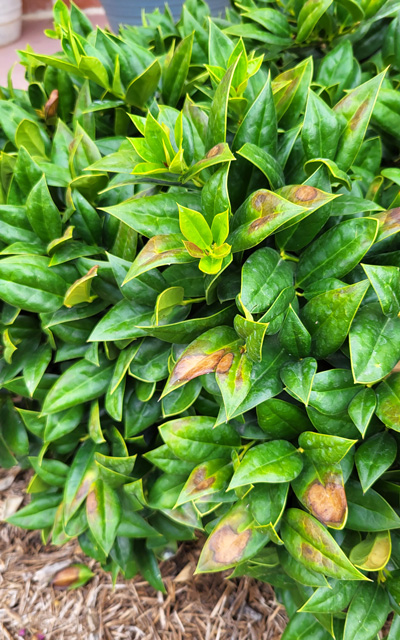
Answer: This is one of three things. It is possible that the plants got too dry one time in the past few weeks. Hollies do not wilt. It’s easy to let them get too dry, then water without knowing that they are in distress. The plants continue to go downhill. We saw a lot of that last summer, and it’s beginning to show up again this year.
It’s also possible that the plants were watered at some time when the sun was hitting the leaves during the heat of the day. When I first saw your photo that’s what I thought had happened. These leaves look like they’ve been blistered by sun. But that would only be the outer layer of leaves. When you told me “all of the leaves” I switched my thoughts to the ”too dry” concept.
Carissa hollies, out of all the dwarf selections of Ilex cornuta (Chinese holly) has always seemed to me to be the least tolerant of hot, reflective planting sites. If these plants are against a hot wall, and if they get afternoon sun in the summer, that could be a big part of the problem.
Please put those three thoughts into the mental data base and see what comes out. This is not insect- or disease-related.
QUESTION 8
PLEASE GIVE ME A BACKGROUND ON BAGWORMS (WHERE THEY COME FROM? TREATMENT? ARE THEY TERMINAL?)
Question: We have 30 acres, probably 40 percent of them thick with eastern redcedar junipers. I’m seeing several bagworms on them. Where do they come from? Are they terminal? Is there any treatment? Craig P., Caddo Mills.
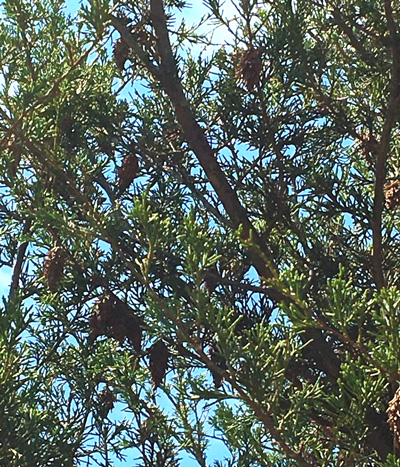
Answer: Bagworms are widespread across Texas and the South, so I guess we can say that bagworms come from other bagworms. In trying to find you a good university website with all the information, I learned some interesting facts about their overwintering life cycles. Rather than just copying it and trying to look smarter than I really am, I’ll just give you a link to a fact sheet from Penn State University. I wasn’t aware, for example, that the female bagworms never fly. I’ll let you read up on it all here.
They are definitely not “terminal” unless we allow them to be. They are easily controlled with almost any general-purpose organic or inorganic insecticide as long as it is applied while they are actively feeding (usually June here in Texas). By the time they quit feeding and tie their bags around the twigs it will be too late to spray.
